April 2022 Floods over East Coast South Africa: Interactions between a Mesoscale Convective System and a Coastal Meso-Low
Abstract
1. Introduction
2. Datasets and Methods
3. Results
3.1. Synoptic Setting
3.2. MCS and Meso-Low Interactions and Rainfall Timing
4. Discussion
5. Conclusions
Author Contributions
Funding
Institutional Review Board Statement
Informed Consent Statement
Data Availability Statement
Acknowledgments
Conflicts of Interest
Appendix A
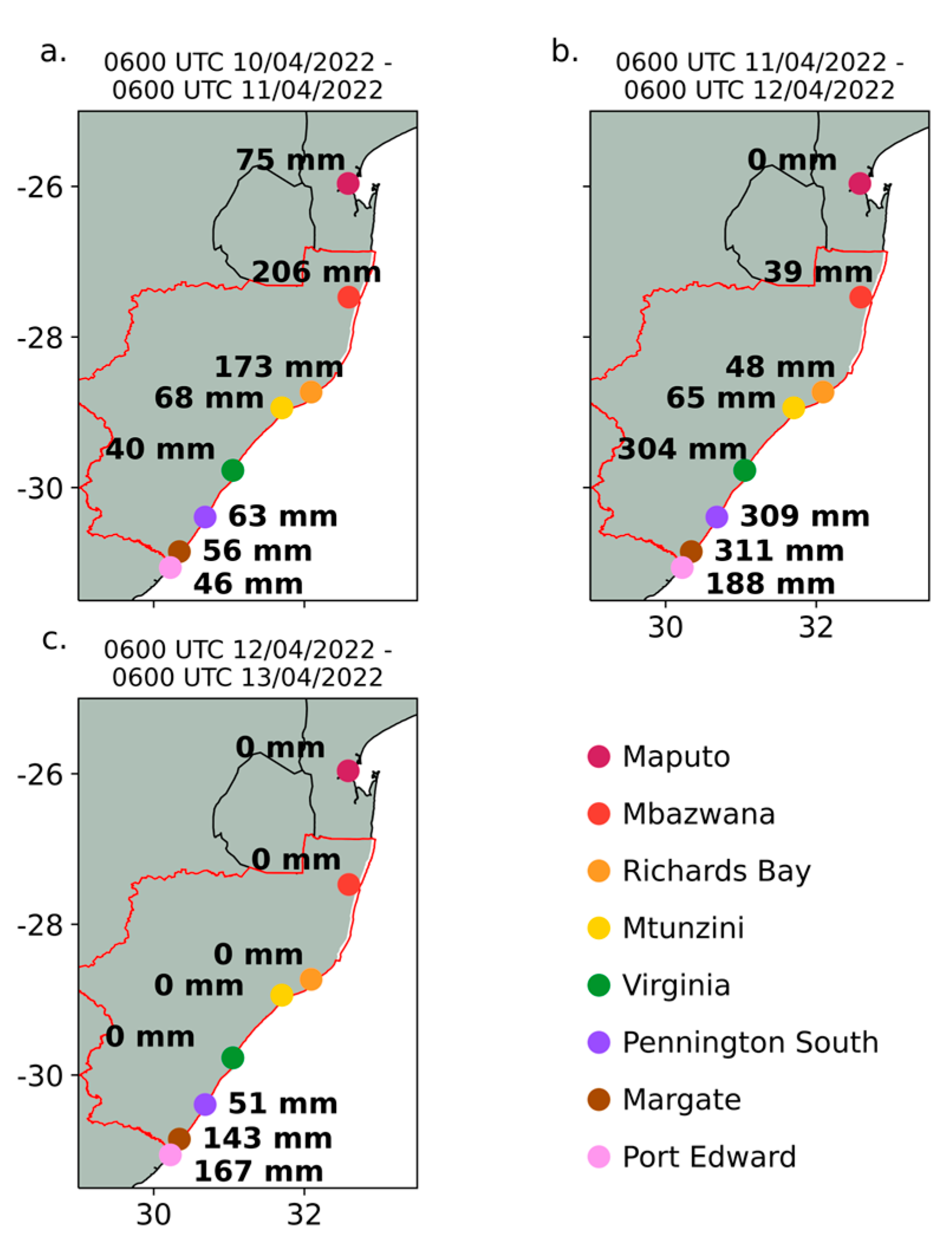
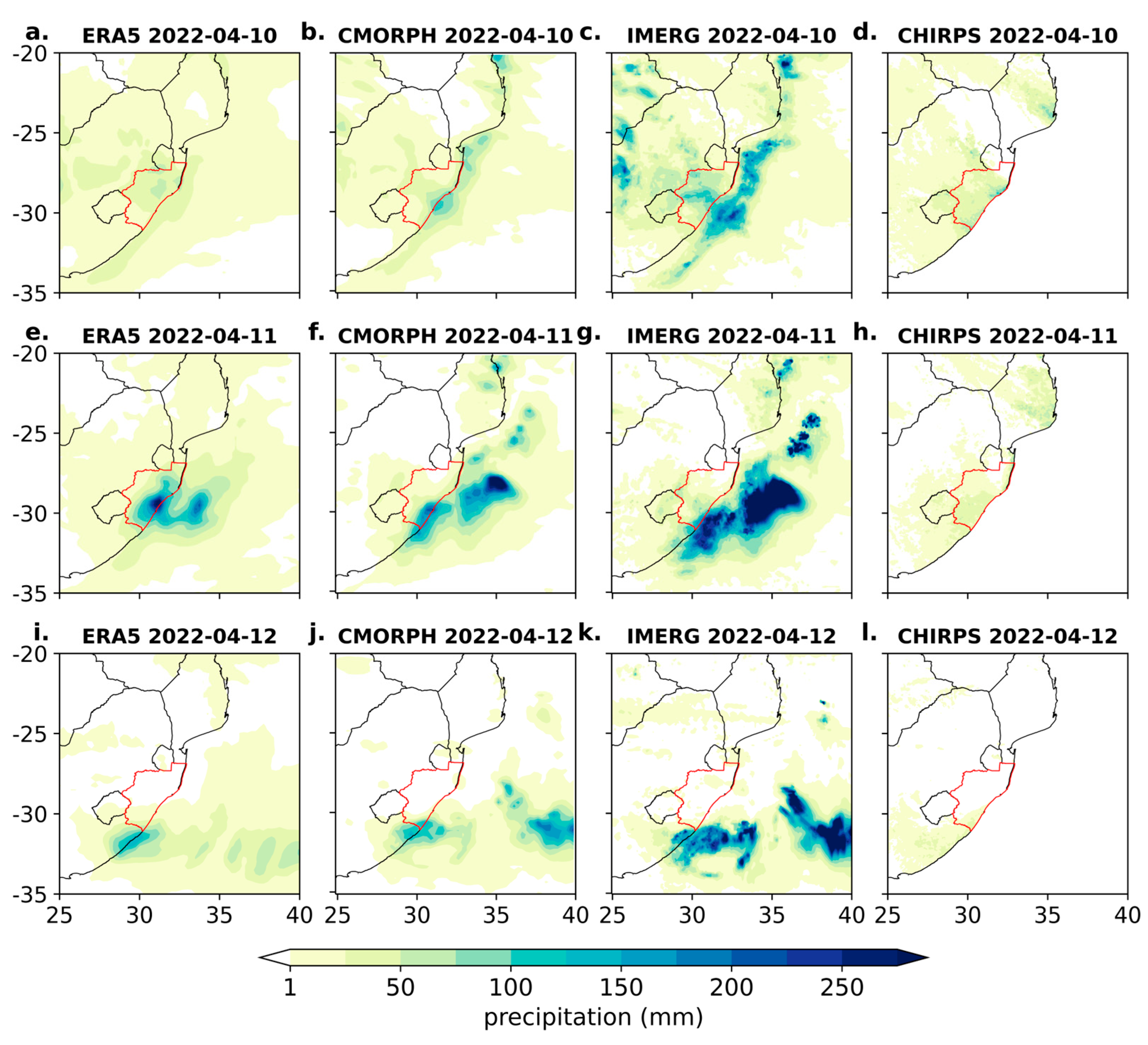
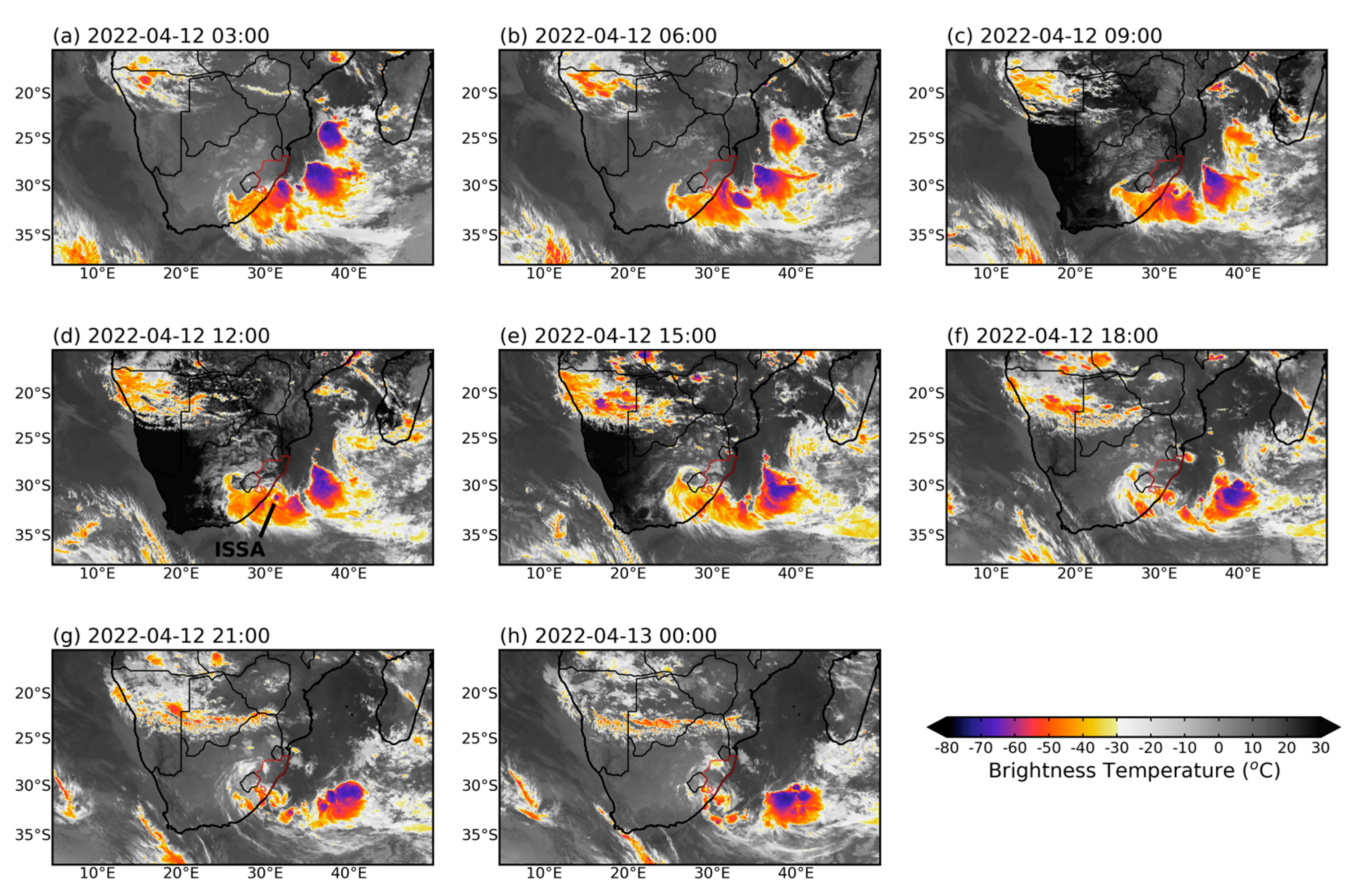

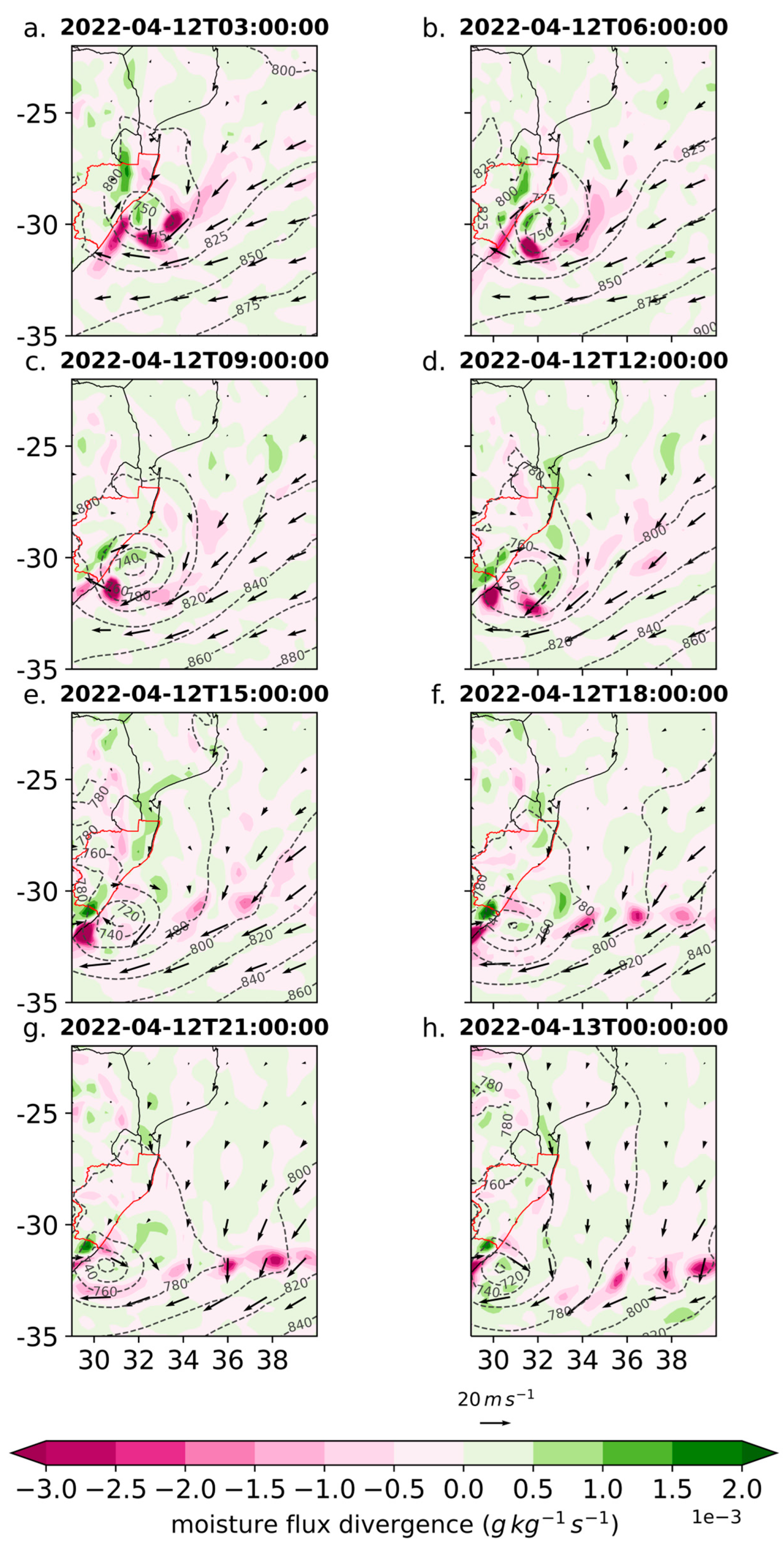
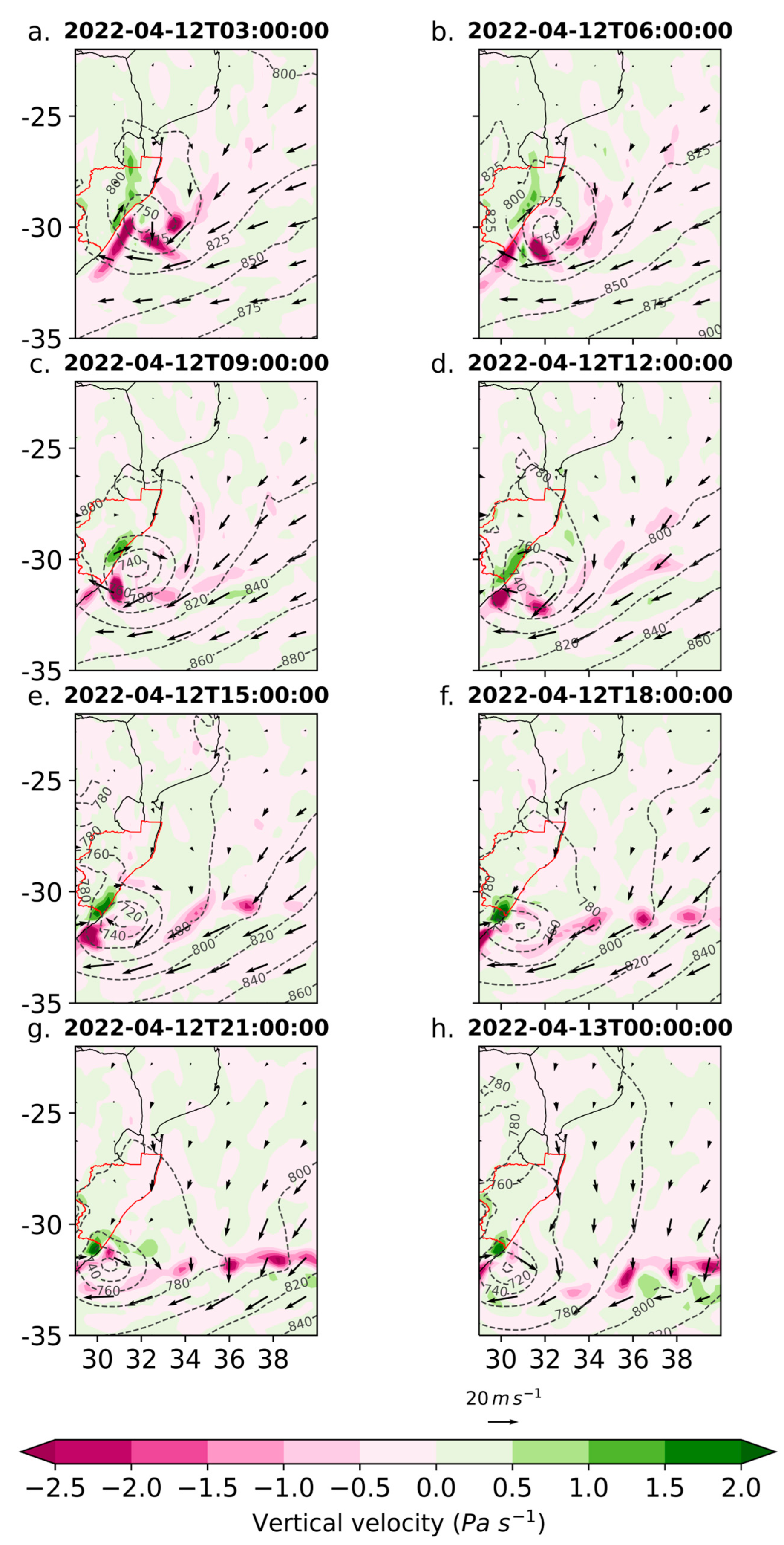
References
- Diab, R.; Preston-Whyte, R.; Washington, R. Distribution of rainfall by synoptic type over Natal, South Africa. Int. J. Climatol. 1991, 11, 877–888. [Google Scholar] [CrossRef]
- Ndlovu, M.; Clulow, A.D.; Savage, M.J.; Nhamo, L.; Magidi, J.; Mabhaudhi, T. An assessment of the impacts of climate variability and change in KwaZulu-Natal Province, South Africa. Atmosphere 2021, 12, 427. [Google Scholar] [CrossRef]
- South Africa Government. National State of Disaster in numbers—18 April 2022. Available online: https://www.gov.za/speeches/national-state-disaster-numbers-%E2%80%93-18-april-2022-18-apr-2022-0000 (accessed on 2 November 2022).
- South Africa Government. President Cyril Ramaphosa: Declaration of a National State of Disaster to Respond to Widespread Flooding. Available online: https://www.gov.za/speeches/president-cyril-ramaphosa-declaration-national-state-disaster-respond-widespread-flooding (accessed on 2 November 2022).
- Grab, S.; Nash, D.J. A new flood chronology for Kwa-Zulu Natal (1836–2022). The April 2022 Durban floods in historical context. In Proceedings of the 36th Annual conference of South African Society for Atmosphere Sciences, Pretoria, South Africa, 30 October 2022. [Google Scholar]
- Badenhorst, P.; Cooper, J.; Crowther, J.; Gonsalves, J.; Laubscher, W.; Grobler, N.; Mason, T.; Illenberger, W.; Perry, J.; Reddering, J.; et al. Survey of September 1987 Natal floods. Natl. Sci. Programmes Unit CSIR 1989, 164, 136. [Google Scholar]
- Bopape, M.-J.M.; Sebego, E.; Ndarana, T.; Maseko, B.; Netshilema, M.; Gijben, M.; Landman, S.; Phaduli, E.; Rambuwani, G.; Van Hemert, L.; et al. Evaluating South African weather service information on Idai tropical cyclone and KwaZulu-Natal flood events. S. Afr. J. Sci. 2021, 117, 1–13. [Google Scholar] [CrossRef]
- BBC. South Africa Floods: Death Toll after Durban Rains Rises to 60. 2019. Available online: https://www.bbc.com/news/world-africa-48036252 (accessed on 2 November 2022).
- Singleton, A.; Reason, C.J.C. Numerical simulations of a severe rainfall event over the Eastern Cape coast of South Africa: Sensitivity to sea surface temperature and topography. Tellus A Dyn. Meteorol. Oceanogr. 2006, 58, 335–367. [Google Scholar] [CrossRef]
- Singleton, A.; Reason, C.J.C. A numerical model study of an intense cutoff low pressure system over South Africa. Mon. Weather Rev. 2007, 135, 1128–1150. [Google Scholar] [CrossRef]
- Pyle, D.M.; Jacobs, T.L. The Port Alfred floods of 17–23 October 2012: A case of disaster (mis) management? Jamba: J. Disaster Risk Stud. 2016, 8, 1–8. [Google Scholar] [CrossRef][Green Version]
- Triegaardt, D.O.; Terblanche, D.E.; van Heerden, J.; Laing, M.V. The Natal Flood of September 1987. In South African Weather Bureau Technical Paper; Weather Bureau, Department of Transport: Pretoria, South Africa, 1988. [Google Scholar]
- Mpungose, N.; Thoithi, W.; Blamey, R.C.; Reason, C.J.C. Extreme rainfall events in southeastern Africa during the summer. Theor. Appl. Climatol. 2022, 150, 185–201. [Google Scholar] [CrossRef]
- Hart, N.C.; Reason, C.J.C.; Fauchereau, N. Tropical–extratropical interactions over Southern Africa: Three cases of heavy summer season rainfall. Mon. Weather. Rev 2010, 138, 2608–2623. [Google Scholar] [CrossRef]
- Hart, N.C.; Reason, C.J.C.; Fauchereau, N. Cloud bands over Southern Africa: Seasonality, contribution to rainfall variability and modulation by the MJO. Clim. Dyn. 2013, 41, 1199–1212. [Google Scholar] [CrossRef]
- Taljaard, J.J. Cut-off lows in the South African region. In South African Weather Bureau Technical Paper; Weather Bureau, Department of Transport: Pretoria, South Africa, 1985. [Google Scholar]
- Blamey, R.C.; Reason, C.J.C. Numerical simulation of a mesoscale convective system over the east coast of South Africa. Tellus A Dyn. Meteorol. Oceanogr. 2009, 61, 17–34. [Google Scholar] [CrossRef][Green Version]
- Blamey, R.C.; Reason, C.J.C. Mesoscale convective complexes over southern Africa. J. Clim. 2009, 25, 753–766. [Google Scholar] [CrossRef]
- Morake, D.M.; Blamey, R.C.; Reason, C.J.C. Long-lived mesoscale convective systems over eastern South Africa. J. Clim. 2021, 34, 6421–6439. [Google Scholar] [CrossRef]
- Singleton, A.T.; Reason, C.J.C. Variability in the characteristics of cut-off low pressure systems over subtropical southern Africa. Int. J. Climatol. 2007, 27, 295–310. [Google Scholar] [CrossRef]
- WMO. WMO predicts first “triple-dip” La Niña of the century. Available online: https://public.wmo.int/en/media/press-release/wmo-predicts-first-%E2%80%9Ctriple-dip%E2%80%9D-la-ni%C3%B1a-of-century (accessed on 2 November 2022).
- Allan, R.J.; Reason, C.J.C.; Lindesay, J.A.; Ansell, T.J. Protracted ENSO episodes and their impacts in the Indian Ocean region. Deep Sea Res. Part II Top. Stud. Oceanogr. 2003, 50, 2331–2347. [Google Scholar] [CrossRef]
- Favre, A.; Hewitson, B.; Tadross, M.; Lennard, C.; Cerezo-Mota, R. Relationships between cutoff lows and the semiannual and southern oscillations. Clim. Dyn. 2012, 38, 1473–1487. [Google Scholar] [CrossRef]
- Reason, C.J.C.; Allan, R.J.; Lindesay, J.A.; Ansell, T.J. ENSO and climatic signals across the Indian Ocean basin in the global context: Part I, interannual composite patterns. Int. J. Climatol. 2000, 20, 1285–1327. [Google Scholar] [CrossRef]
- Hersbach, H.; Bell, B.; Berrisford, P.; Hirahara, S.; Horányi, A.; Muñoz-Sabater, J.; Nicolas, J.; Peubey, C.; Radu, R.; Schepers, D.; et al. The ERA5 global reanalysis. Q. J. R. Meteorol. Soc. 2020, 146, 1999–2049. [Google Scholar] [CrossRef]
- Funk, C.; Peterson, P.; Landsfeld, M.; Pedreros, D.; Verdin, J.; Shukla, S.; Husak, G.; Rowland, J.; Harrison, L.; Hoell, A.; et al. The climate hazards infrared precipitation with stations—A new environmental record for monitoring extremes. Sci. Data 2015, 2, 150066. [Google Scholar] [CrossRef]
- Xie, P.; Joyce, R.; Wu, S.; Yoo, S.-H.; Yarosh, Y.; Sun, F.; Lin, R. NOAA CDR Program: NOAA Climate Data Record (CDR) of CPC Morphing Technique (CMORPH) High Resolution Global Precipitation Estimates, Version 1; NOAA National Centers for Environmental Information: Asheville, NC, USA, 2019. Available online: https://doi.org/10.25921/w9va-q159 (accessed on 2 December 2022). [CrossRef]
- Whitaker, J.S.; Hamill, T.M.; Wei, X.; Song, Y.; Toth, Z. Ensemble data assimilation with the NCEP global forecast system. Mon. Weather Rev. 2008, 136, 463–482. [Google Scholar] [CrossRef]
- Reynolds, R.W.; Smith, T.M.; Liu, C.; Chelton, D.B.; Casey, K.S.; Schlax, M.G. Daily high-resolution-blended analyses for sea surface temperature. J. Clim. 2007, 20, 5473–5496. [Google Scholar] [CrossRef]
- Draxler, R.R.; Hess, G. An overview of the HYSPLIT_4 modelling system for trajectories. Aust. Meteorol. Mag. 1998, 47, 295–308. [Google Scholar]
- Gimeno, L.; Eiras-Barca, J.; Durán-Quesada, A.M.; Dominguez, F.; van der Ent, R.; Sodemann, H.; Sánchez-Murillo, R.; Nieto, R.; Kirchner, J.W. The residence time of water vapour in the atmosphere. Nat. Rev. Earth Environ. 2021, 2, 558–569. [Google Scholar] [CrossRef]
- Mawren, D.; Blamey, R.C.; Hermes, J.; Reason, C.J.C. On the importance of the Mozambique Channel for the climate of southeastern Africa. Clim. Dyn. 2022, 1–21. [Google Scholar] [CrossRef]
- Spavins-Hicks, Z.D.; Washington, R.; Munday, C. The Limpopo low-level jet: Mean climatology and role in water vapor transport. J. Geophys. Res. Atmos. 2021, 126, e2020JD034364. [Google Scholar] [CrossRef]
- Blamey, R.C.; Kolusu, S.R.; Mahlalela, P.; Todd, M.C.; Reason, C.J.C. The role of regional circulation features in regulating El Niño climate impacts over southern Africa: A comparison of the 2015/2016 drought with previous events. Int. J. Climatol. 2018, 38, 4276–4295. [Google Scholar] [CrossRef]
- Bell, F.G.; Maud, R.R. Landslides associated with the colluvial soils overlying the Natal Group in the greater Durban region of Natal, South Africa. Environ. Geol. 2000, 39, 1029–1038. [Google Scholar] [CrossRef]
- Huffman, G.J.; Stocker, E.F.; Bolvin, D.T.; Nelkin, E.J.; Tan, J. GPM IMERG Final Precipitation L3 1 day 0.1 Degree × 0.1 degree V06; Savtchenko, A., Ed.; Goddard Earth Sciences Data and Information Services Center (GES DISC): Greenbelt, MD, USA, 2019. Available online: https://disc.gsfc.nasa.gov/datasets/GPM_3IMERGDF_06/summary (accessed on 2 December 2022).
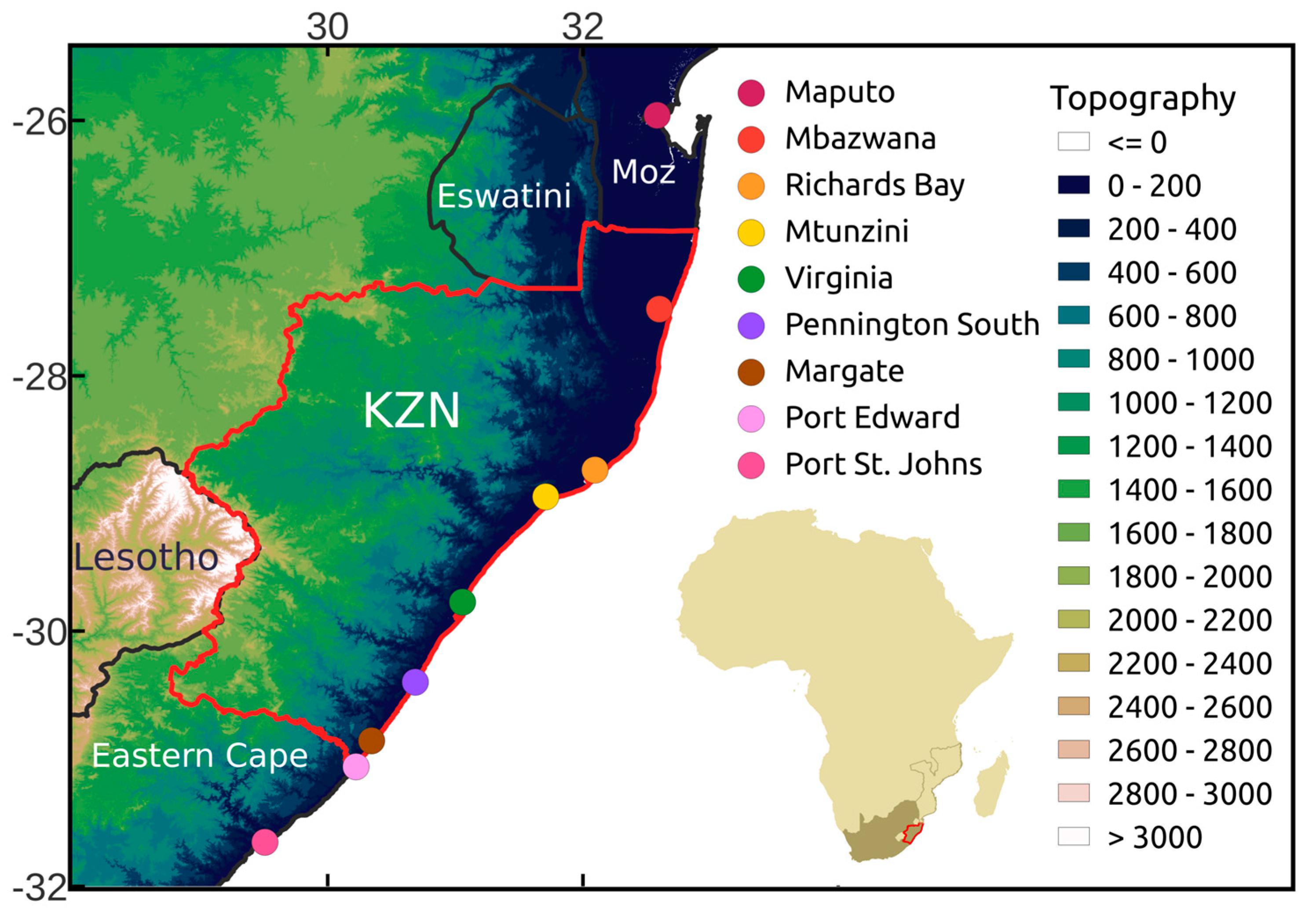

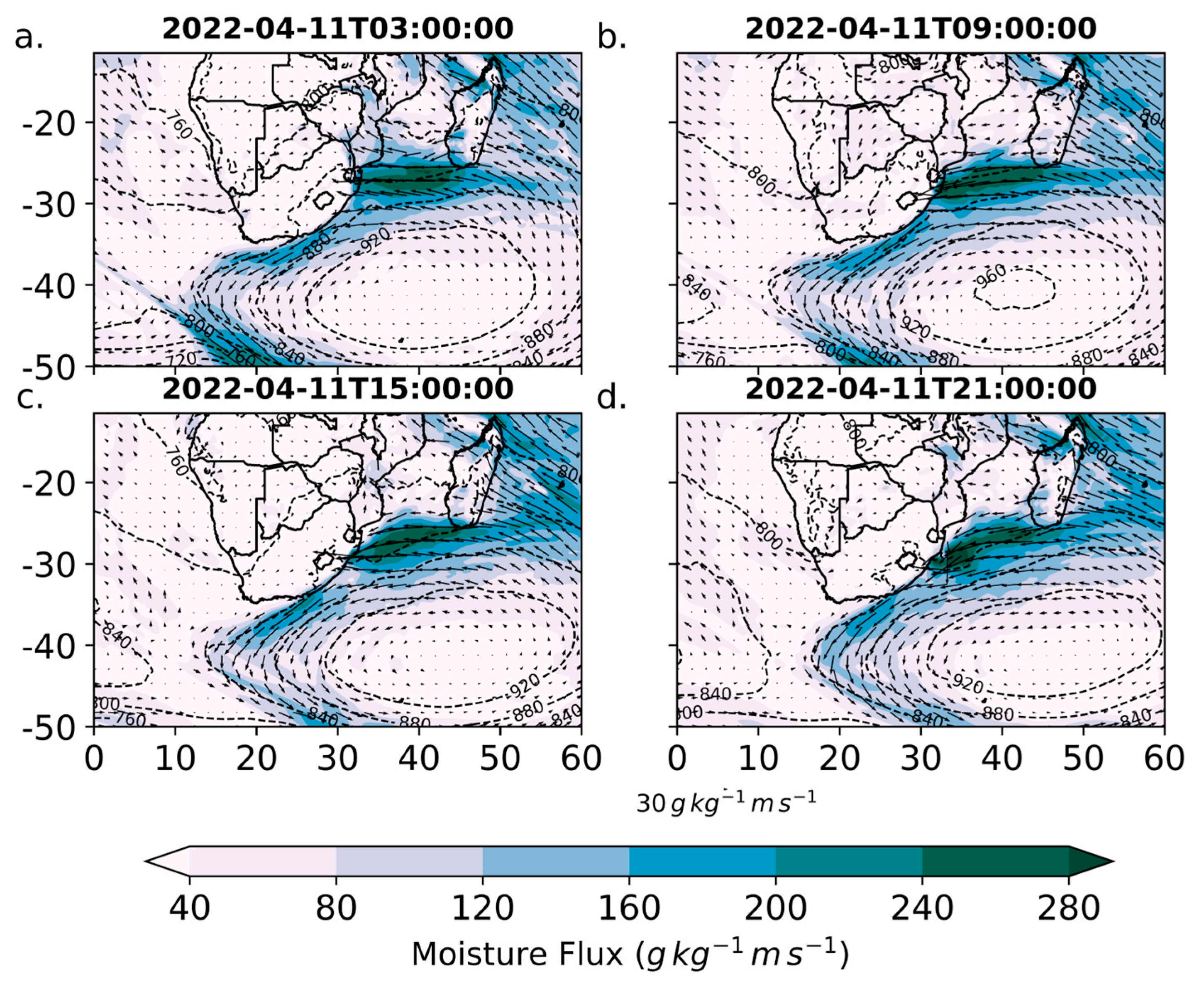
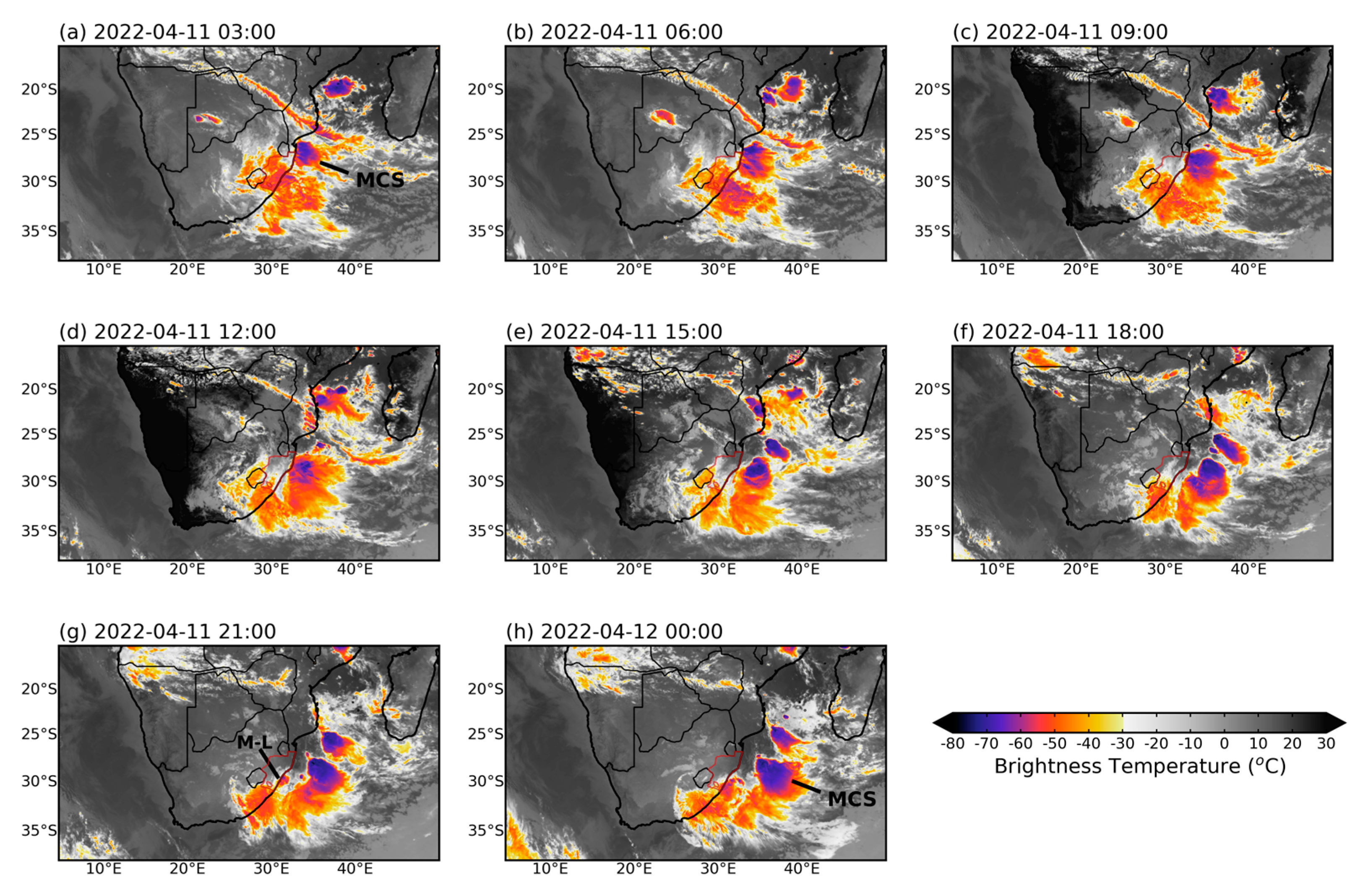
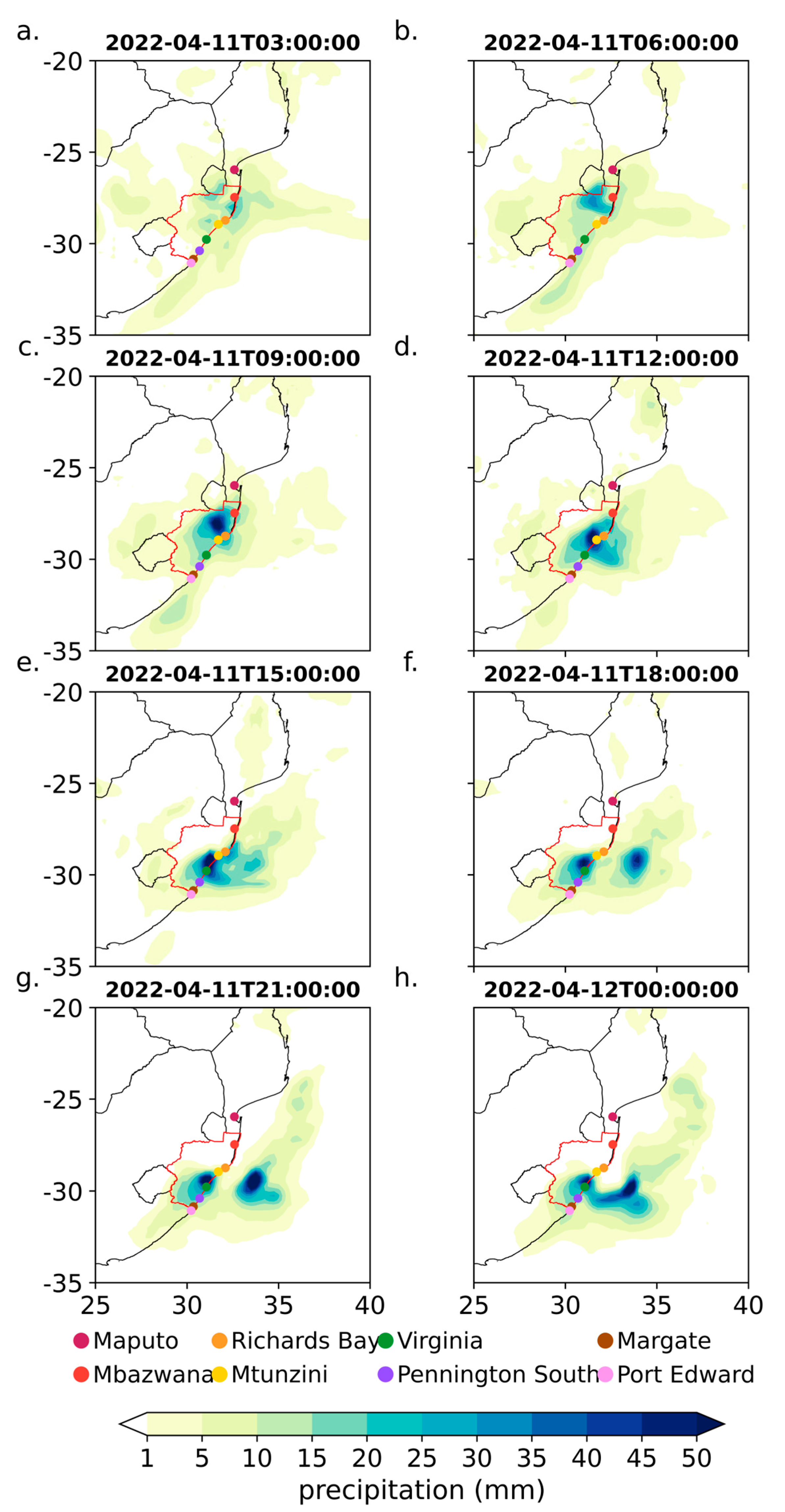
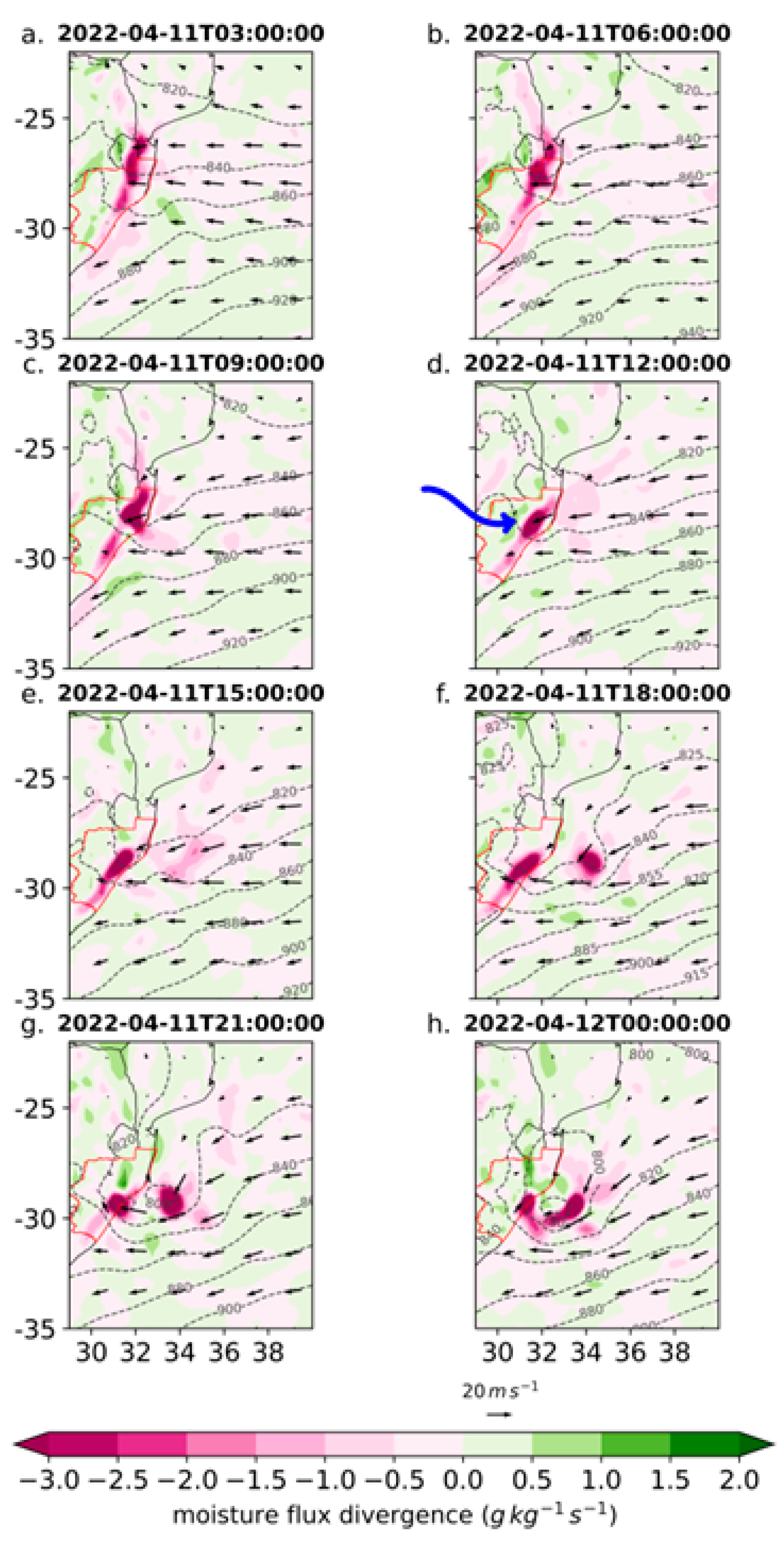
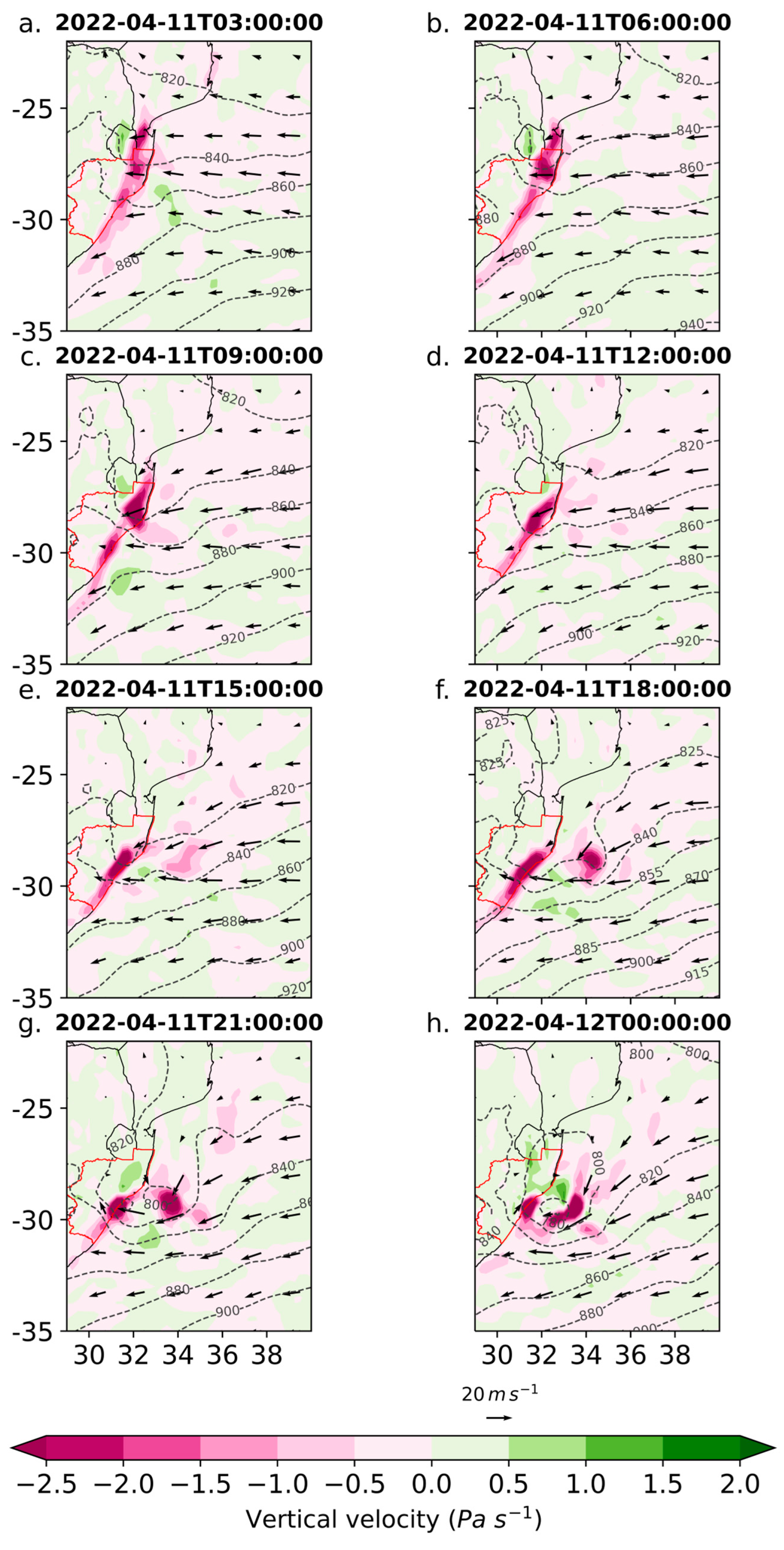
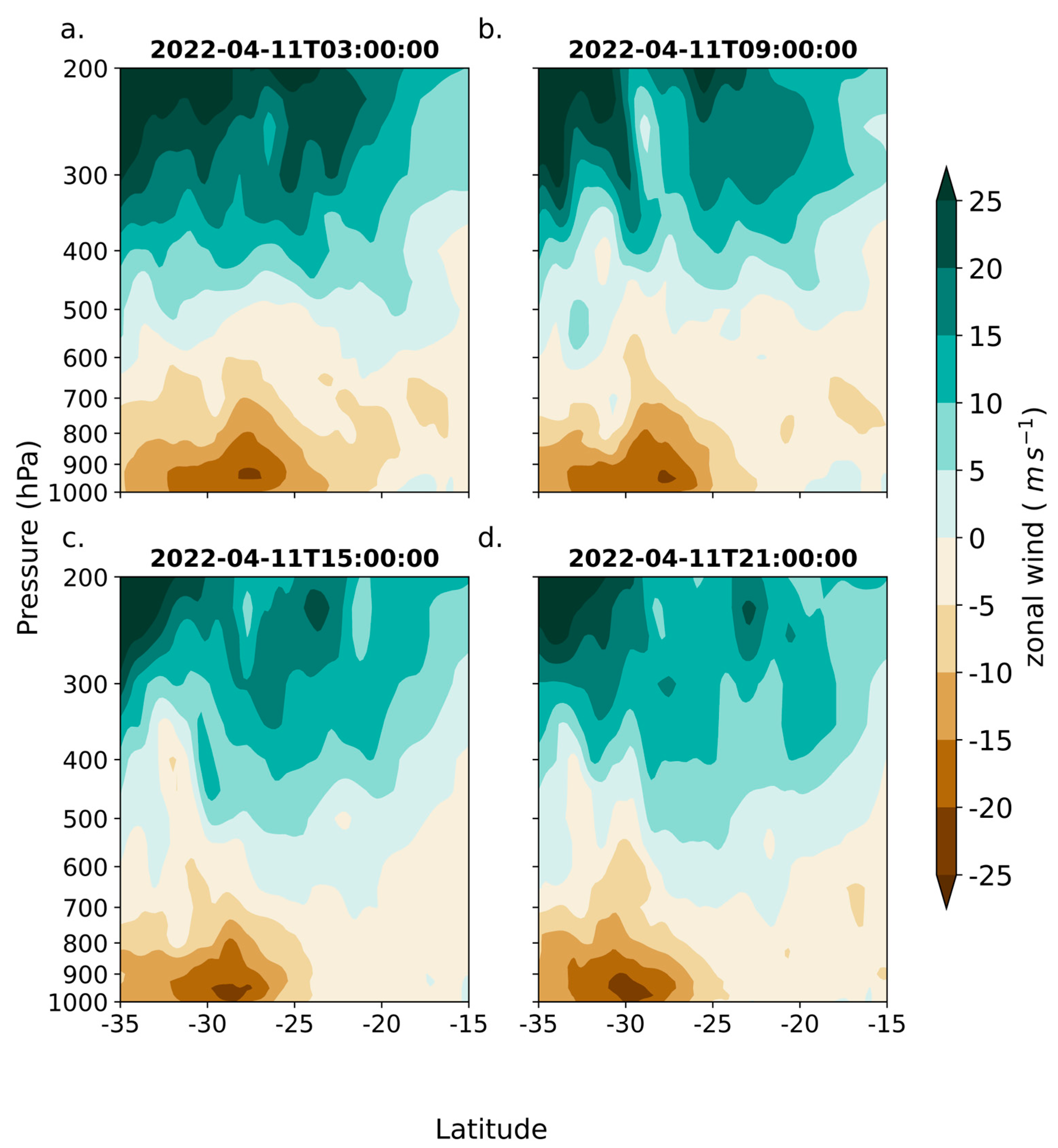


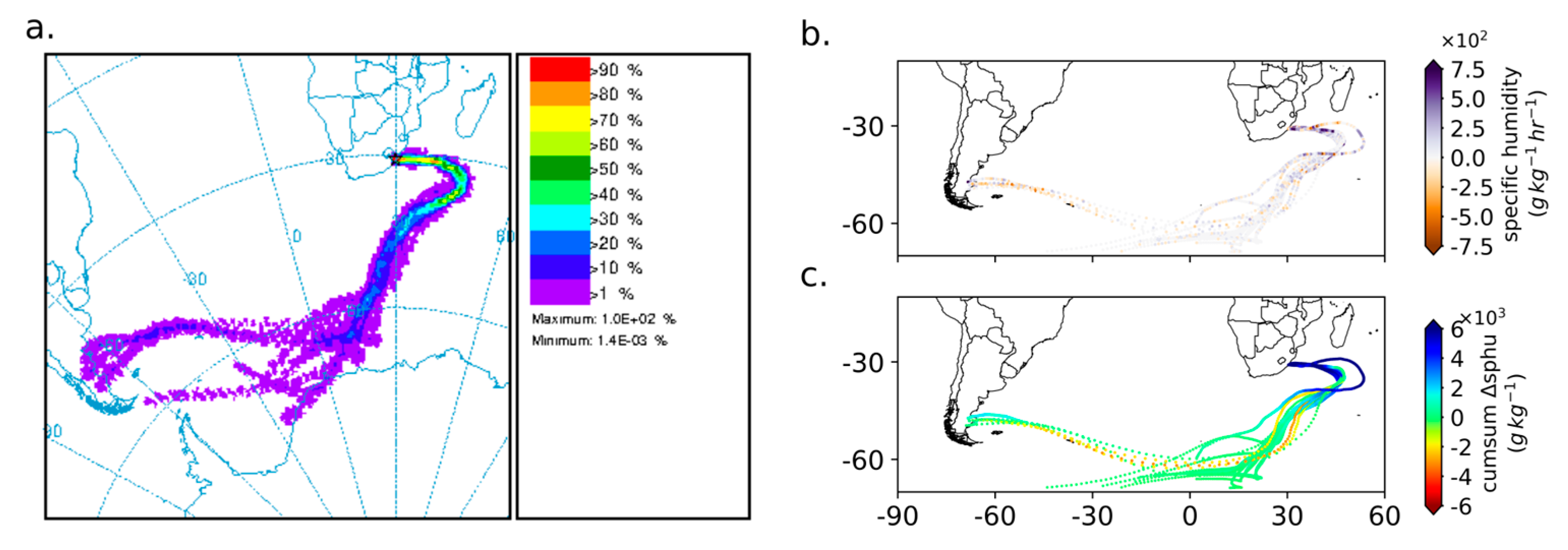
Disclaimer/Publisher’s Note: The statements, opinions and data contained in all publications are solely those of the individual author(s) and contributor(s) and not of MDPI and/or the editor(s). MDPI and/or the editor(s) disclaim responsibility for any injury to people or property resulting from any ideas, methods, instructions or products referred to in the content. |
© 2022 by the authors. Licensee MDPI, Basel, Switzerland. This article is an open access article distributed under the terms and conditions of the Creative Commons Attribution (CC BY) license (https://creativecommons.org/licenses/by/4.0/).
Share and Cite
Thoithi, W.; Blamey, R.C.; Reason, C.J.C. April 2022 Floods over East Coast South Africa: Interactions between a Mesoscale Convective System and a Coastal Meso-Low. Atmosphere 2023, 14, 78. https://doi.org/10.3390/atmos14010078
Thoithi W, Blamey RC, Reason CJC. April 2022 Floods over East Coast South Africa: Interactions between a Mesoscale Convective System and a Coastal Meso-Low. Atmosphere. 2023; 14(1):78. https://doi.org/10.3390/atmos14010078
Chicago/Turabian StyleThoithi, Wanjiru, Ross C. Blamey, and Chris J. C. Reason. 2023. "April 2022 Floods over East Coast South Africa: Interactions between a Mesoscale Convective System and a Coastal Meso-Low" Atmosphere 14, no. 1: 78. https://doi.org/10.3390/atmos14010078
APA StyleThoithi, W., Blamey, R. C., & Reason, C. J. C. (2023). April 2022 Floods over East Coast South Africa: Interactions between a Mesoscale Convective System and a Coastal Meso-Low. Atmosphere, 14(1), 78. https://doi.org/10.3390/atmos14010078





